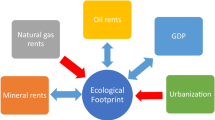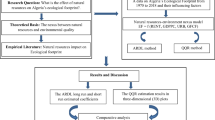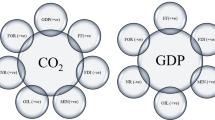Abstract
The present study examines the symmetric and asymmetric effects of natural resource exploitation on the ecological footprint in Saudi Arabia during the period 1981–2018. The analysis is performed for total natural resources and different types of natural resources, including oil, natural gas, and minerals. This research employs the dynamic Autoregressive Distributed Lag (DYNARDL) simulation approach. In addition to its statistical and computational superiority, the DYNARDL allows assessing the environmental repercussions of shocks that occurred on natural resources in both the short- and long-run. The findings suggest that total, oil, and natural gas rents have a positive symmetric association with the ecological footprint in the long run, while no significant impact is identified for mineral resources. When conducting the asymmetric analysis, the findings reveal that only increases in total, oil, and natural gas rents deteriorate the ecological footprint in the long run, while no effects are confirmed for decreases in natural resource rents. The shock analysis reveals that a 10% increase in total and oil rents leads to environmental degradation by 3% in the long run, while a similar upsurge in natural gas rents induces a 4% deterioration in environmental quality. These findings may help design effective resource-use policies to achieve environmental sustainability in Saudi Arabia.






Similar content being viewed by others
Data availability
The dataset used during the study is available from the corresponding author upon reasonable request.
References
Abbasi KR, Adedoyin FF, Abbas J, Hussain K (2021a) The impact of energy depletion and renewable energy on CO2 emissions in Thailand: fresh evidence from the novel dynamic ARDL simulation. Renew Energy 180:1439–1450
Abbasi KR, Shahbaz M, Jiao Z, Tufail M (2021b) How energy consumption, industrial growth, urbanization, and CO2 emissions affect economic growth in Pakistan? A novel dynamic ARDL simulations approach. Energy 221:119793
Aeknarajindawat N, Suteerachai B, Suksod P (2020) The impact of natural resources, renewable energy, economic growth on carbon dioxide emission in Malaysia. Int J Energy Econ Policy 10:211–218
Akadiri SS, Adebayo TS, Riti JS, Awosusi AA, Inusa EM (2022) The effect of financial globalization and natural resource rent on load capacity factor in India: an analysis using the dual adjustment approach. Environ Sci Pollut Res 29(59):89045–89062
Aller C, Ductor L, Grechyna D (2021) Robust determinants of CO2 emissions. Energy Econ 96:105154
Anwar A, Younis M, Ullah I (2020) Impact of urbanization and economic growth on CO2 emission: a case of Far East Asian countries. Int J Environ Res Public Health 17(7):2531
Balsalobre-Lorente D, Shahbaz M, Roubaud D, Farhani S (2018) How economic growth, renewable electricity and natural resources contribute to CO2 emissions? Energy Policy 113:356–367
Bekun FV, Alola AA, Sarkodie SA (2019) Toward a sustainable environment: Nexus between CO2 emissions, resource rent, renewable and nonrenewable energy in 16-EU countries. Sci Total Environ 657:1023–1029
Ben-Salha O, Hakimi A, Zaghdoudi T, Soltani H, Nsaibi M (2022) Assessing the impact of fossil fuel prices on renewable energy in China using the novel dynamic ARDL simulations approach. Sustainability 14(16):10439
Clemente J, Montañés A, Reyes M (1998) Testing for a unit root in variables with a double change in the mean. Econ Lett 59(2):175–182
Commoner B, Corr M, Stamler PJ (1971) The causes of pollution. Environ: Sci Policy Sustain Dev 13(3):2–19
Coskuner C, Paskeh MK, Olasehinde-Williams G, Akadiri SS (2020) Economic and social determinants of carbon emissions: evidence from organization of petroleum exporting countries. J Public Aff 20(3):e2092
Danish, Baloch MA, Mahmood N, Zhang JW (2019) Effect of natural resources, renewable energy and economic development on CO2 emissions in BRICS countries. Sci Total Environ 678(632):638
Dauda L, Long X, Mensah CN, Salman M (2019) The effects of economic growth and innovation on CO2 emissions in different regions. Environ Sci Pollut Res 26(15):15028–15038
Desai BH, Sidhu BK (2019) Climate change as a common concern of humankind: some reflections on the international law-making process. In: Jaria-Manzano J and Borrás S (eds) Research Handbook on Global Climate Constitutionalism. Edward Elgar Publishing, Cheltenham, pp 153–175
Dietz T, Rosa EA (1997) Effects of population and affluence on CO2 emissions. Proc Natl Acad Sci 94(1):175–179
Dong K, Dong X, Dong C (2019) Determinants of the global and regional CO2 emissions: what causes what and where? Appl Econ 51(46):5031–5044
Dou Y, Zhao J, Malik MN, Dong K (2021) Assessing the impact of trade openness on CO2 emissions: evidence from China-Japan-ROK FTA countries. J Environ Manage 296:113241
Ehrlich PR, Holdren JP (1971) Impact of population growth: complacency concerning this component of man’s predicament is unjustified and counterproductive. Science 171(3977):1212–1217
Emir F, Karlilar S (2022) Application of RALS cointegration test assessing the role of natural resources and hydropower energy on ecological footprint in emerging economy. Energy Enviro. https://doi.org/10.1177/0958305X211073807
Erdoğan S, Çakar ND, Ulucak R, Kassouri Y (2021) The role of natural resources abundance and dependence in achieving environmental sustainability: evidence from resource-based economies. Sustain Dev 29(1):143–154
Global Footprint Network (2022) Measure what you treasure. https://www.footprintnetwork.org. Accessed 23 Nov 2022
Gyamfi BA, Adebayo TS (2023) Do natural resource volatilities and renewable energy contribute to the environment and economic performance? Empirical evidence from E7 economies. Environ Sci Pollut Res 30:19380–19392
Hassan ST, Xia E, Khan NH, Shah SMA (2019) Economic growth, natural resources, and ecological footprints: evidence from Pakistan. Environ Sci Pollut Res 26(3):2929–2938
Jian X, Afshan S (2022) Dynamic effect of green financing and green technology innovation on carbon neutrality in G10 countries: fresh insights from CS-ARDL approach. Economic Research-Ekonomska Istraživanja. https://doi.org/10.1080/1331677X.2022.2130389
Keßler S, Richard D, Zimmer S (2020) Report ecological footprint – reloaded. Technical report, Institut fir biologësch Landwirtschaft an Agrarkultur Luxemburg. https://csdd.public.lu/content/dam/csdd/fr/actualites/2020/Report-Ecological-Footprint-Luxembourg-IBLA.pdf. Accessed 28 Oct 2022
Khan SAR, Sharif A, Golpîra H, Kumar A (2019) A green ideology in Asian emerging economies: from environmental policy and sustainable development. Sustain Dev 27(6):1063–1075
Khan A, Chenggang Y, Hussain J, Bano S, Nawaz A (2020) Natural resources, tourism development, and energy-growth-CO2 emission nexus: a simultaneity modeling analysis of BRI countries. Resour Policy 68:101751
Khan MK, Babar SF, Oryani B, Dagar V, Rehman A, Zakari A, Khan MO (2022) Role of financial development, environmental-related technologies, research and development, energy intensity, natural resource depletion, and temperature in sustainable environment in Canada. Environ Sci Pollut Res 29:622–638
Kongbuamai N, Bui Q, Yousaf HMAU, Liu Y (2020) The impact of tourism and natural resources on the ecological footprint: a case study of ASEAN countries. Environ Sci Pollut Res 27(16):19251–19264
Kripfganz S, Schneider DC (2020) Response surface regressions for critical value bounds and approximate p-values in equilibrium correction models 1. Oxford Bull Econ Stat 82(6):1456–1481
Kwakwa PA, Alhassan H, Adu G (2020) Effect of natural resources extraction on energy consumption and carbon dioxide emission in Ghana. Int J Energy Sect Manage 14(1):20–39
Leybourne SJ (1995) Testing for unit roots using forward and reverse Dickey-Fuller regressions. Oxford Bull Econ Stat 57(4):559–571
Mahmood H, Alkhateeb TTY, Furqan M (2020) Industrialization, urbanization and CO2 emissions in Saudi Arabia: Asymmetry analysis. Energy Rep 6:1553–1560
Mehmood U (2022) Natural resources and CO2 emissions nexus: sustainable development path for South Asian countries. Kuwait Journal of Sciences 49:1–13
Myhre G, Shindell D, Bréon FM, Collins W, Fuglestvedt J, Huang J, Koch D, Lamarque JF, Lee D, Mendoza B, Nakajima T, Robock A, Stephens G, Takemura T, Zhang H (2013) Anthropogenic and natural radiative forcing. In: Climate Change 2013: The Physical Science Basis. Contribution of Working Group I to the Fifth Assessment Report of the Intergovernmental Panel on Climate Change [Stocker, T.F., D. Qin, G.-K. Plattner, M. Tignor, S.K. Allen, J. Boschung, A. Nauels, Y. Xia, V. Bex and P.M. Midgley (eds.)]. Cambridge University Press, Cambridge, United Kingdom and New York, NY, USA
National Oceanic and Atmospheric Administration (2022) Trends in Atmospheric Carbon Dioxide. https://gml.noaa.gov/ccgg/trends/data. Accessed 5 Nov 2022
Neves SA, Marques AC, Patrício M (2020) Determinants of CO2 emissions in European Union countries: does environmental regulation reduce environmental pollution? Econ Anal Policy 68:114–125
Pata UK (2021a) Linking renewable energy, globalization, agriculture, CO2 emissions and ecological footprint in BRIC countries: a sustainability perspective. Renew Energy 173:197–208
Pata UK (2021b) Renewable and non-renewable energy consumption, economic complexity, CO2 emissions, and ecological footprint in the USA: testing the EKC hypothesis with a structural break. Environ Sci Pollut Res 28:846–861
Pata UK, Isik C (2021) Determinants of the load capacity factor in China: a novel dynamic ARDL approach for ecological footprint accounting. Resour Policy 74:102313
Pata UK, Aydin M, Haouas I (2021) Are natural resources abundance and human development a solution for environmental pressure? Evidence from top ten countries with the largest ecological footprint. Resour Policy 70:101923
Pata UK, Hizarci AE (2022) Investigating the environmental Kuznets curve in the five most complex countries: insights from a modified ecological footprint model. Energy Environ. https://doi.org/10.1177/0958305X221120255
Philips AQ (2018) Have your cake and eat it too? Cointegration and dynamic inference from autoregressive distributed lag models. Am J Polit Sci 62(1):230–244
Sharif A, Saha S, Loganathan N (2017) Does tourism sustain economic growth? Wavelet-based evidence from the United States. Tour Anal 22(4):467–482
Sharif A, Raza SA, Ozturk I, Afshan S (2019) The dynamic relationship of renewable and nonrenewable energy consumption with carbon emission: a global study with the application of heterogeneous panel estimations. Renew Energy 133:685–691
Sharif A, Baris-Tuzemen O, Uzuner G, Ozturk I, Sinha A (2020) Revisiting the role of renewable and non-renewable energy consumption on Turkey’s ecological footprint: evidence from Quantile ARDL approach. Sustain Cities Soc 57:102138
Shehzad K, Zeraibi A, Zaman U (2022) Testing the N-shaped environmental Kuznets Curve in Algeria: an imperious role of natural resources and economic globalization. Resour Policy 77:102700
Shin Y, Yu B, Greenwood-Nimmo M (2014) Modelling asymmetric cointegration and dynamic multipliers in a nonlinear ARDL framework. In: Sickles RC, Horrace, WC (eds) Festschrift in honor of Peter Schmidt. Springer, New York, pp 281–314
Suki NM, Sharif A, Afshan S, Suki NM (2020) Revisiting the environmental Kuznets curve in Malaysia: the role of globalization in sustainable environment. J Clean Prod 264:121669
Tufail M, Song L, Adebayo TS, Kirikkaleli D, Khan S (2021) Do fiscal decentralization and natural resources rent curb carbon emissions? Evidence from developed countries. Environ Sci Pollut Res 28(35):49179–49190
Umar M, Ji X, Kirikkaleli D, Shahbaz M, Zhou X (2020) Environmental cost of natural resources utilization and economic growth: can China shift some burden through globalization for sustainable development? Sustain Dev 28:1678–1688
United Nations Environment Programme and Climate and Clean Air Coalition (2021) Global methane assessment: benefits and costs of mitigating methane emissions. Nairobi: United Nations Environment Programme. https://www.ccacoalition.org/en/resources/global-methane-assessment-full-report
Wan Q, Miao X, Afshan S (2022) Dynamic effects of natural resource abundance, green financing, and government environmental concerns toward the sustainable environment in China. Resour Policy 79:102954
Wang Y, Zhao T (2015) Impacts of energy-related CO2 emissions: evidence from under developed, developing and highly developed regions in China. Ecol Ind 50:186–195
World Bank (2022) Global Gas Flaring Reduction Partnership (GGFR). https://www.worldbank.org/en/programs/gasflaringreduction/gas-flaring-explained. Accessed 5 Dec 2022
Yi S, Abbasi KR, Hussain K, Albaker A, Alvarado R (2023) Environmental concerns in the United States: can renewable energy, fossil fuel energy, and natural resource depletion help? Gondwana Res 117:41–55
Yilanci V, Pata UK (2020) Investigating the EKC hypothesis for China: the role of economic complexity on ecological footprint. Environ Sci Pollut Res 27(26):32683–32694
Zafar MW, Zaidi SAH, Khan NR, Mirza FM, Hou F, Kirmani SAA (2019) The impact of natural resources, human capital, and foreign direct investment on the ecological footprint: the case of the United States. Resour Policy 63:101428
Zhang B, Wang Z, Wang B (2018) Energy production, economic growth and CO2 emission: evidence from Pakistan. Nat Hazards 90(1):27–50
Zivot E, Andrews DWK (1992) Further evidence on the great crash, the oil-price shock, and the unit-root hypothesis. J Bus Econ Stat 20(1):25–44
Zmami M, Ben-Salha O (2020) An empirical analysis of the determinants of CO2 emissions in GCC countries. Int J Sust Dev World 27(5):469–480
Zmami M, Ben-Salha O, Almarshad SO, Chekki H (2021) The contribution of mining sector to sustainable development in Saudi Arabia. J Sustain Min 20(2):122–135
Zuo S, Zhu M, Xu Z, Oláh J, Lakner Z (2021) The dynamic impact of natural resource rents, financial development, and technological innovations on environmental quality: empirical evidence from BRI economies. Int J Environ Res Public Health 19(1):130
Acknowledgements
The authors gratefully acknowledge the approval and the support of this research study by the grant no. BSAA-2022-11-1253 from the Deanship of Scientific Research at Northern Border University, Arar, K.S.A.
Author information
Authors and Affiliations
Contributions
Conceptualization, O. B. S. and M. Z.; methodology, O. B. S.; data curation, O. B. S.; software, O. B. S.; formal analysis, O. B. S.; writing—original draft preparation, O. B. S. and M. Z.; writing—review and editing, O. B. S. and M. Z. Both authors have read and approved the submitted version of the manuscript.
Corresponding author
Ethics declarations
Ethics approval and consent to participate
Not applicable.
Consent for publication
Not applicable
Competing interests
The authors declare no competing interests.
Additional information
Responsible Editor: Arshian Sharif
Publisher's note
Springer Nature remains neutral with regard to jurisdictional claims in published maps and institutional affiliations.
Appendix
Rights and permissions
Springer Nature or its licensor (e.g. a society or other partner) holds exclusive rights to this article under a publishing agreement with the author(s) or other rightsholder(s); author self-archiving of the accepted manuscript version of this article is solely governed by the terms of such publishing agreement and applicable law.
About this article
Cite this article
Ben-Salha, O., Zmami, M. Analyzing the symmetric and asymmetric effects of disaggregate natural resources on the ecological footprint in Saudi Arabia: insights from the dynamic ARDL approach. Environ Sci Pollut Res 30, 59424–59442 (2023). https://doi.org/10.1007/s11356-023-26683-1
Received:
Accepted:
Published:
Issue Date:
DOI: https://doi.org/10.1007/s11356-023-26683-1




